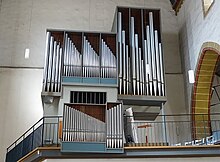Reglerkirche (Erfurt)

The Reglerkirche (also called Augustinus Church) is a church in the old town of Erfurt . It serves as a place of worship for a Protestant community and is one of the larger churches in the old town. In the GDR it was considered a center for church music in Erfurt.
history
The construction of the Romanesque Reglerkirche was started in 1130 by the "regulated" Augustinian Canons . It was completed in 1238. The church emerged from a Romanesque collegiate church, which is said to have been founded as early as 1117. The beginnings of the pen have not yet been properly clarified. In 1362 parish rights were granted for baptism, sermon, confession and visiting the sick.
The first building probably had the shape of a three-aisled basilica of four bays with a retracted, rectangular closed choir and a pair of towers on the west side. The west facade of the sacred building is unique for the churches in the city, the nave and choir are of a Gothic style, despite the Romanesque ceilings .
The great city fire of April 1, 1291, which destroyed almost the entire eastern part of the city from the Neuwerk monastery to the Krämpfertor , meant that, with the exception of the tower block, a large part of the church had to be demolished. In the year 1293, an archbishop's donation said: “Church severely destroyed by the fire” - a new building is to take place soon.
In 1525 the church was converted into a Protestant parish church as part of the Reformation . In a fire in 1660, large parts of the attached monastery buildings burned down. During the French occupation under Napoleon, the church, looted and devastated inside, served as a hospital. In the first half of the 19th century, the construction and equipment of the church continued to deteriorate, so that it had to be closed in 1845. With a state grant from the Prussian king, it was restored from 1857 to 1860 and completely reconstructed from 1890 to 1901. The roof structure was damaged in bombing raids during World War II. Between 1960 and 1973 the church was again extensively renovated. After the First World War, in front of the church was the war memorial for the fallen soldiers of the Hunter Regiment on Horseback No. 6 ; however, it was dismantled as early as 1939 at the instigation of the NS mayor Walter Kießling . It showed a hunter in front of a horse on an elaborately designed base. The bronze statue Mildenfurther Kreuzmensch, created by Thuringian sculptor Volkmar Kühn in 2002, is currently standing next to the outside main portal .
Furnishing
The late Gothic winged altar is of high art-historical importance . Created around 1465 by the “masters of the regulator altar”, who are not known by name, it is one of the highest quality and best preserved altars of this period in Central Germany. It presents itself in three different states:
- The closed altar shows 12 apostles, martyrs and saints who represent the communion's bond with the history of the Church, among them and first and foremost the Doctor of the Church Augustine.
- The open altar presents 4 large panel pictures against a gold background, which symbolizes God's presence in the world. On the left Jesus Christ crowned with thorns and flagellation, on the right Ascension and Pentecost.
- Further open, 13 carved reliefs can be seen in front of a richly gilded background, the largest in the center is the coronation of Mary.
The pulpit (probably 1687) comes from the monastery church of St. Pankratius Hamersleben and shows the four evangelists.
organ
An earlier organ prospectus was designed by the well-known artist Alexander Linnemann from Frankfurt.
Today's organ in the Reglerkirche was built in several stages between 1968 and 1977 by the organ builder Friedrich Löbling (Erfurt). The breastwork was installed in 1983. The instrument has 38 registers on three manuals and a pedal . The playing and stop actions are mechanical.
|
|
|
|
|||||||||||||||||||||||||||||||||||||||||||||||||||||||||||||||||||||||||||||||||||||||||||||||||||||||||||||||||||||||||||||||||||||||||||
- Coupling : I / II, III / II, I / P, II / P, III / P
literature
- Gerhard Kaiser, Roland Möller: The Reglerkirche in Erfurt. Schnell und Steiner publishing house, Regensburg 1998, ISBN 3-7954-6109-X .
- Karl-Heinz Meißner: The Reglerkirche in Erfurt and its altar. Lukas Verlag, Berlin 2011, ISBN 978-3-86732-107-5 .
Individual evidence
- ↑ a b The Protestant Churches in Erfurt. 2nd edition, Evangelische Verlagsanstalt, Berlin 1989.
- ↑ Gerhard Haiser and Roland Möller: The Reglerkirche to Erfurt. Schnell Art Guide No. 2332. Verlag Schnell & Steiner Regensburg 1998, ISBN 3-7954-6109-X .
- ↑ a b c Erich Wiemann: The Reglerkirche in Erfurt. Ohlenroth'sche Buchdruckerei, Erfurt 1949.
- ↑ a b c Communications of the Association for History and Archeology of Erfurt , 63rd Issue, New Series, Issue 10, 2002, ISBN 3-9807188-2-4 .
- ↑ Cf. catalog raisonné of the Linnemann glass painting workshop in the Linnemann archive.
- ↑ Information on the organ of the Reglerkirche (PDF; 15 kB)
Web links
Coordinates: 50 ° 58 ′ 30 ″ N , 11 ° 2 ′ 10.1 ″ E





